|
Sorry
for being so late with yesterdayís
update. We had our report ready at 11.30
p.m., rushed out of the hotel and looked
out for the closest ISDN public
telephone.
After
walking through some very narrow streets
we found ourselves in the amusement area
of Sendai. In front of us the gray phone -
so we rushed into the booth.
A
few people were standing around the
telephone booth. For the first time in
Japan we had a funny feeling about the
environment we were in. But we unpacked
our notebook and started to get the
internet connection.
As
we were working, we felt shadows of the
underground observing us.
The first trial: Password was not
accepted.
Shoot, try once again but unsuccessful
again.
The third trial with another phone number:
Connection unsuccessful.
While
we were trying hard to get the reports out
to the net, a foreigner (in Japan, anybody
who does not have the feature of Hiroe.)
came up towards us: now what do we
do?
|
He
sticked his hand in his bag - big PANIC
written all over our faces and it was
getting bigger by the seconds. Sven
quickly hid the notebook - the guy simply
started to put colorful small papers on
the outside glass of the phone
booth.
After
he covered half of the glass portion of
the phone booth with his colorful papers
he disappeared into the
darkness.
We
quickly left the phone booth and stared at
the art that was just completed by the
guy: Photos of minimally dressed girls
with large bold phone numbers.
A
ha!
Now
we saw that every street corner was filled
with such papers. There were no spaces
that were left empty and they managed to
do this within 15 Minutes (this must have
been around 2000 pieces).
In
order to spare us from putting ourselves
in an uncomfortable situation we did not
take any photos of this scene, so
unfortunately only text but we are sure
you can imagine this.
|
|
In
the next morning, we packed our stuff and
started to head to the next city as we
have been doing since almost a
week.
On
the way to the station we came across to
this Tatami-manufacturer. Finally we
were able to see how the matts, on which
we have been sleeping in last few days,
were made. Almost all processes are manual
work.
Such
manufacturer as this one belong to a
rather large operation.
So
such Tatami-Mats costs starting 20.000 Yen
(ca. 400,- DM) and as anything else in
Japan there is no limit to how high it
could get.
One
old (but chauvinistic) japanese old-saying
says: `New Tatami and new wife are needed
every 10 years!`
|
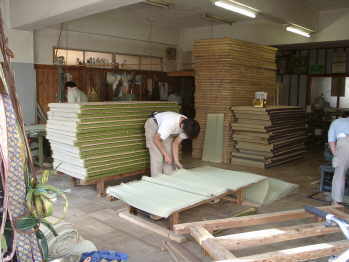
|
|
|
From
the train station it took us some 50
minutes to go with the regional JR-train
to Matsushima. This village is located at
the pacific coastline and is very well
known as a fisher village.
The
appr. 260 small islands off the coastline
are scattered in the ocean and reminded us
of Thailand a lot.
|
|
In
this region we recognized a lot of caves
dug in the rock formations, a lot of them
containing buddhist statues decorated with
colorfull clothes, flowers or
coins.
This
view also didn`t really fit into our
picture of Japan so far.
This
overgrown stairs we would have rather
expected in a South American rain forest
at an old gravesite of the
Inkas.
Matsushima
has many different faces, adding new
points to the picture of Japan we had
encountered so far.
|

|
|
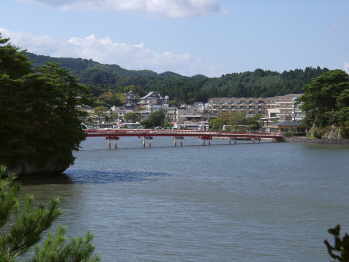
|
This
252 m long bridge connects the island
Fukuurajima with the mainland and is the
only toll-bridge for pedestrians we got to
know so far.
The
200 Yen (some 2.- US-$) per person were
well worth it though. From the island you
have a very nice panoramic view over the
whole bay of Matsushima.
Therefore
we skipped the boat trip in the bay area
and saved the 1,400 Yen (some 14.- US-$
per person).
|
|
The
island of Fukuurajima is a natural
botanical garden with more than 250
different species of plants and in its
natural beauty a huge contrast to the
`styled` gardens of Kanazawa some days
ago.
We
had great fun discovering the island in
the shadow of the trees and agreed that
the trip to Matsushima was well worth the
effort. A special thanks to the
information center which does a very good
job taking care of the visitors over
there.
Even
a group of volunteers is available to
guide interested visitors through city and
bay area. Unfortunately we didn`t have
enough time to take advantage of this
offer.
|
|
|
|
After
we started being hungry again from so much
walking we stopped at a small
restaurant.
At
first we had some doubts about the hygene
in this place. That`s why we ordered only
cooked dishes and not the cold soba
noodles which would have suited best for
the hot temperature.:
Two noodle soups with tempura, a chinese
noodle soup and barbecued beef.
In
traditional restaurants in Japan the menue
very often is placed written on single
sheets of paper placed on the walls. The
guest has to scann a full 360 degrees to
get the full offer of dishes.
Here
you see Sven with some of todays
specials.
|
|
After
our order was placed Mr. and Mrs. Kitajo
got to work.
In
their small kitchen they cooked, boiled
and deep fried our dishes exclusively from
fresh ingredients.
The
three soups and noodle dishes were ready
after just 15 minutes.
|
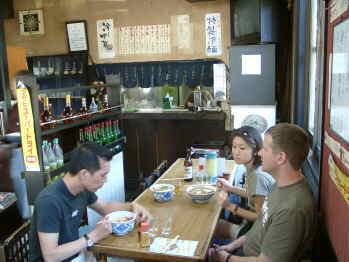
|
|
|
Then
Sven was aked to have a seat at the table
next to us. `You will need more space`
said Mr. Kitajo very
determined.
Then
he put the small charcoal grill on the
table. The meat had to be grilled at the
table, but was so thin that it only took a
few moments till it was done.
This
dish must be quite popular as the walls of
the room appeared to have been
smoked by cooking fumes many times
before.The discoloring around the fan had
a charcoaleish colour but gave the
restaurant `Taishoie` its individual
charme.
The
dishes were all very delicious and also
one of the cheapest warm meals we had
eaten on this tour.
|
|
At
the stopover in Sendai we fullfilled a
long awaited wish of ours: we played
Pachinko.
Although
we passed these gambling places with an
amazing noise polution up to the street
quite often already we never dared going
into one of these places so
far.
Now
the four of us went ahead and crossed the
doorstep behind the fake flower bouquets
and the colourfull
advertising-flags.
|
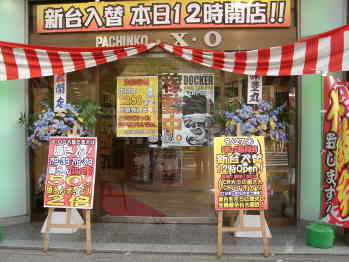
|
|
|
Inside
we were welcomed by an deafening noise -
not just from the uncountable number of
small metall balls but also from loud rock
music.
In
long rows the gamblers were sitting in
front of their Pachinko-machines side by
side and stared in suspense on the small
balls which should bring them
fortune.
Close
to their feet there were up to four or
five small plastic containers filled with
the metall balls.
After
we had understood briefly the concept of
playing we also wanted to try it
ourselves, 1,000 Yen (appr. 10 US-$) we
had to pay as a minimum starting amount.
We got a plastic card for this amount
which we had to insert into a Pachinko
machine.
|
|
The
metall balls shot immediately into the
feeder. The game itself does not require
any skill. You only need to twist a knob
to send the balls on their way.(The
experienced gentleman to our right locked
the knob with two 10 Yen coins and
automated the task with this)
After
a short and noisy 5 minutes our feeder was
empty and all the money gone. We left the
`gambling-hall` with buzzing heads and
cigarette smell in our clothes.
On
the way out we saw the potential rewards
for winning consisting of leather bags,
watches and many more precious things. As
it is forbidden here to play for money the
winners get these objects
instead.
(We
heard though that there is a kind of pawn
shop very close to the Pachinko place that
exchanges the goods for real Yen.) Very
clever we thought.
|
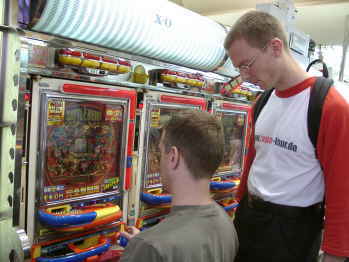
|
|
|
|
|
Our
daily special:
`The
Puzzler` (Are you a Japan
expert?)
New
impressions and curiosities as a daily Q
& A.
7)
What is the object on the photo
?
(Answer:
just click on the photo)
|
|